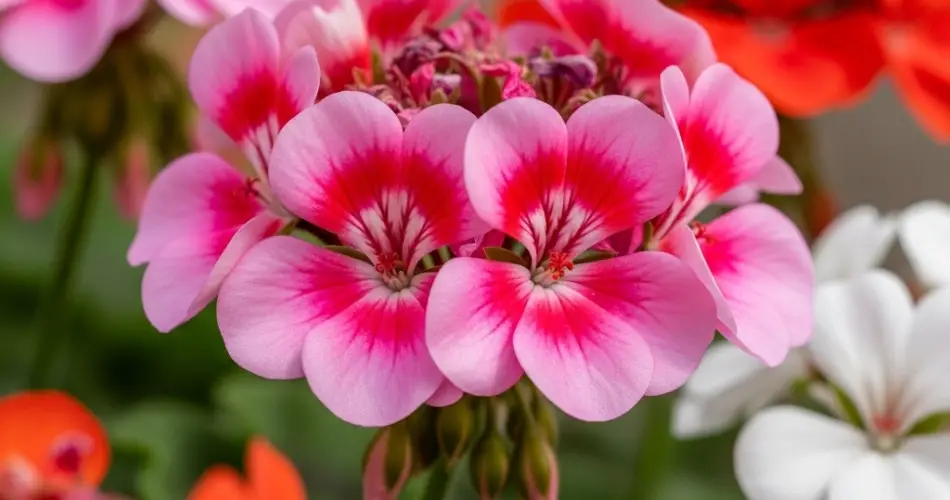Geraniums are well-loved for their bright, long-lasting flowers, pleasant fragrance, and low-maintenance care. Whether planted indoors in containers or outside in garden beds, geraniums can thrive and bloom year-round with the right attention. While many gardeners enjoy seasonal blooms, it’s entirely possible to keep geraniums blooming profusely throughout the year—by focusing on a few essential strategies to maximize growth, flower production, and plant health.
Here’s a comprehensive guide to help you make the most of your geraniums, ensuring vibrant, continuous blooms no matter the season.
Choose the Right Variety
To get maximum flowering, start with the right type of geranium. Zonal geraniums (Pelargonium × hortorum) are the most common for vibrant blooms, while ivy-leaved types are ideal for hanging baskets and window boxes. Regal and scented varieties are also beautiful, though they may have more specific needs.
Zonal geraniums are generally more robust and capable of blooming repeatedly with minimal fuss—making them an excellent choice for year-round color.
Provide Plenty of Light
Geraniums are sun-loving plants. For the best flower production, they need at least 6 hours of direct sunlight per day. Indoors, place your plants on a bright windowsill—preferably south- or west-facing. If natural light is limited, supplement with grow lights to ensure your plants continue to receive adequate light during shorter winter days.
Low light leads to leggy growth and fewer blooms, so ensuring proper lighting is one of the most critical steps to maximizing yield.
Use Well-Draining Soil
Healthy roots are essential for flowering. Plant your geraniums in well-draining soil to avoid root rot and encourage strong, healthy root systems. A good mix might include potting soil with added perlite or coarse sand to improve drainage.
Avoid overly rich, compact soils that hold too much moisture. If you’re planting in containers, make sure they have drainage holes at the bottom to prevent waterlogging.
Water Wisely
Geraniums prefer the soil to dry slightly between waterings. Overwatering can stunt growth and reduce flowering, while underwatering can cause stress and leaf drop. The key is consistency: water when the top inch of soil feels dry to the touch.
During the growing season, watering once or twice a week is often sufficient, depending on your local climate and the size of your container. In winter, reduce watering frequency, but don’t let the plant completely dry out.
Feed for Continuous Blooms
To keep geraniums blooming year-round, regular feeding is essential. Use a balanced liquid fertilizer (such as 10-10-10 or 20-20-20) every two weeks during the active growing season—spring through early fall.
For flowering emphasis, switch to a fertilizer with higher phosphorus content (such as 10-30-20) to promote more flower buds. Always follow the recommended dilution on the label and avoid overfeeding, which can cause salt buildup in the soil and damage roots.
Prune and Deadhead Regularly
One of the best ways to maximize bloom output is to regularly remove faded flowers. This process, known as deadheading, directs the plant’s energy toward producing new blooms instead of forming seeds.
Additionally, prune leggy or weak stems to encourage a bushier, more compact plant. Pinching back the tips of stems encourages branching, which results in more flowering points. Regular grooming also keeps the plant looking tidy and vigorous.
Repot When Necessary
Container-grown geraniums can become root-bound over time, which limits their ability to absorb water and nutrients. If you notice roots growing out of the drainage holes or the plant’s growth slowing down despite good care, it’s time to repot.
Choose a container just one size larger, and refresh the soil to give your plant renewed nutrients and space to grow.
Provide Winter Care
To maintain year-round blooms, you need to keep your geraniums healthy through the winter. If you live in a region with cold winters, bring outdoor geraniums indoors before the first frost.
Once indoors, reduce watering and feeding, and ensure they get at least 4–6 hours of bright light each day. You may not see as many blooms in mid-winter, but proper care will keep your plants healthy and ready to flower again as soon as spring returns.
Control Pests and Diseases
Keep an eye out for common pests like aphids, spider mites, and whiteflies. If you notice any, treat them early using neem oil or insecticidal soap. Good airflow, clean pots, and avoiding overhead watering can also help prevent fungal issues like powdery mildew or root rot.
Healthy plants are more resilient and more likely to bloom abundantly throughout the year.
Conclusion
With the right care, geraniums can reward you with colorful blooms nearly all year long. By focusing on light, soil, watering, feeding, pruning, and seasonal adjustments, you can easily turn a few plants into a vibrant, ever-flowering display—indoors or out.
Whether you’re a beginner gardener or looking to get more from your existing geraniums, following these steps will help you achieve maximum yield and enjoy the rich, cheerful beauty of this classic plant every month of the year.



